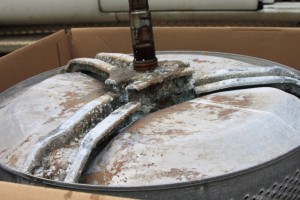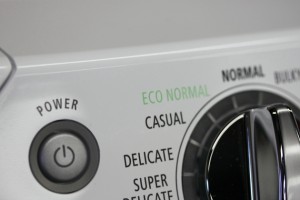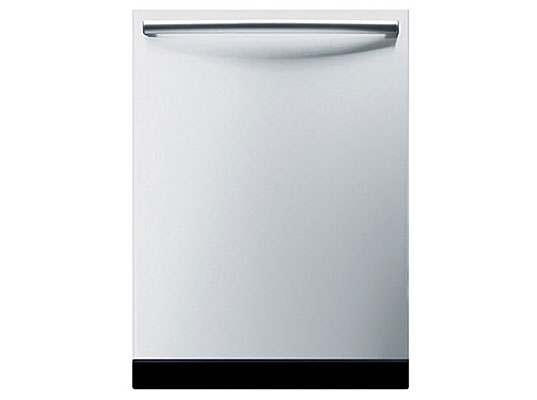Dishwashers – Detergents and Best Practices!
 Getting the best results from your dishwashers means taking many things into consideration. Below we will break down what we think are the three big things you need to pay attention to get the best results. Detergents, Loading, and Food Level.
Getting the best results from your dishwashers means taking many things into consideration. Below we will break down what we think are the three big things you need to pay attention to get the best results. Detergents, Loading, and Food Level.
DETERGENTS –
Getting the best results with your dishwasher starts with a good undestanding of dishwasher detergents. Just like with H.E. washers, using the right soap goes a long way towards keeping your dishwasher running its best and will ensure the best cleaning results.
The right soap and amount depends on the dishwasher so you should read your use and care guide that came with your dishwasher. On most dishwashers there is a fill line inside the dispenser and you should not go above that line. Don’t think that adding more soap will give you better results. Extra soap can cause build up resulting in poor washing performance.
You also need to be aware that a lot of detergents are now phosphate free. This is to help the environment since phosphates can damage rivers and streams. Phosphates in detergents help cut down the minerals that are naturally found in water such as calcium and lime. This of course means that over time you may start to see more mineral build up in your dishwasher.
If you see excessive white build up, you should buy a cleaning agent to help clean your dishwasher. You can buy dishwasher cleaning tablets from our store that have proven to be very effective. These cleaning tablets help remove the calcium and lime that the the phosphate free soap is no longer removing.
Also don’t forget the importance of rinse aids. Rinse aid will help the soiled water run off your dishes and will not only help in better rinsing results which means cleaner dishes but will also help you get the best drying results.
LOADING –
None of your dishes should overlap. It’s great to maximize space when we fill the dishwasher, but too often we overcrowd our dishes. This prevents dishes from getting clean. Space the dishes so that each one has the space it needs to get clean. Keep in mind that water flow comes from underneath. So always put dishes, dirty side down. Also try tilting your dishes so that the dirty water can run off during the rinse.
It also matters where you put your dishes. Your bottom rack will should be reserved for pots and pans. In general, the dishes that are on the bottom rack will get cleaner because they are closer to the motor. Also many dishwashers will have a larger spray arm on the bottom. Save glasses and smaller items for your top rack and again remember that spacing is key. Make sure that you only put dishes in that are dishwasher safe.
FOOD LEVEL –
Todays dishwashers do a pretty good job removing food but you still need to scrape your plates in the garbage or disposal. Some dishwashers have a soft food disposal in them or filter and too much food will cause problems. Make sure there are not things on the plates that can cause problems such as non food items.
While you should scrape your plates, make sure you do not pre wash them. This can cause more harm then good. Light soil level means the soap has nothing to attack and may leave your dishes with a film.
———-
Following the above will hopefully help you get the best results with your dishwasher. If you have any questions, please feel free to call us anytime. We are more than happy to assist you in any way we can.
Why HE Detergent?

Why HE detergent?
There is a lot of confusion among some consumers as well as many opinions about the use of HE detergents. With the new high efficiency washing machines built today HE detergent is the only detergent that should be used. Using traditional detergents in these new machines causes many problems. The most critical is the creating of too much suds in the washers that are designed to use less water.
HE detergents are low sudsing and specially designed to provide clean wash loads with less water. Use of regular or traditional detergents not only confuse the washing machines sensing ability but can also create enormous stress on some critical components that may result in early part failure, some of which are critical components that can be very expensive.
READ LABELS CAREFULLY! Some detergents label their detergents as “HE Compatible”. We advise that you do not use these in your low water machines. These detergents are often regular sudsing detergents with slight modifications or no modifications at all. This applies to both front loading and top loading HE washers. With the new water standards by the EPA most units built today are low water models.
The wash action of many HE washers will create more suds with regular detergents than would be found in your classic washer. This will limit the cleaning ability of the detergent to remove stains resulting in poor performance and can stress the tub or create fault codes also known as “ Suds Lock”.
The picture above shows what can happen when regular detergent is used. This machine drum support failed due to the stress of the suds not allowing the drum to spin freely during the high spin portion of the cycle. Each manufacture has specific recommendations so please read your manuals and follow the manufacture guidelines for washing and you will save energy, water, and get the best results from your washer. HE detergents can be found in most brands and are specifically designed to maximize the enhanced performance of your appliance. Using traditional detergent in lower quantities deos not present a work around, your clothes will simply just be less clean and can contribute to an odor in your machine. If you develop an odor in your machine please give us a call we have special chemicals not availiable in stores to treat this condition.
Here is a useful article from the American Cleaning Institute.
If you have any questions please call our office and we would be happy to answer any questions you may have..

Look for this logo on your detergent and read the label carefully.
How to properly Load your Washing Machine
 Best results with your washing machine starts with proper loading. This may seem like a simple matter. In fact, you may be scratching your head right now wondering what the big deal is right?
Best results with your washing machine starts with proper loading. This may seem like a simple matter. In fact, you may be scratching your head right now wondering what the big deal is right?
Well, we have a lot of calls each year that are directly due to improper loading and even though you may be the master of everything clean in your household, you may find out something here that you didn’t know.
A good start is to make sure you add your clothes in the tub loosly, dry, and one at a time. New washers force you to do this, but some of the golden oldies out there will allow you to start water fill first. Adding your clothes to the washer while water is filling is the number one way to overload your washer. This is because as the clothes absorb the water, they compress down with the weight, allowing you to add more than what the washer was designed to handle. Do not dump a hamper of clothes in at once because clothes items can get caught in the tub ring and could get in between the inner wash basket and outer tub. Keep like items together to ensure a balanced load.
How much clothes you can add vary from machine to machine, but the general rule is to stop with the tub looks 75 percent full or covered. In a top load machine, you should still be able to see a couple inches of the inner wash basket. On a front loader, the clothes should not be wanting to fall out of the front opening.
Checking pockets is important. We find all kinds of things in washer drain pumps. Legos, pins, pencils, nails, bobby pins, money (not enough to pay for the service call), among others. This can cause damage to the pump or worse can tear a hole in the drain hose, causing water to gush out onto your floor. Even if you tell your family to empty pockets before putting laundry in the hamper, you need to double check. Remember that you are the last line of defense to keep your washer or your home from being damaged.

